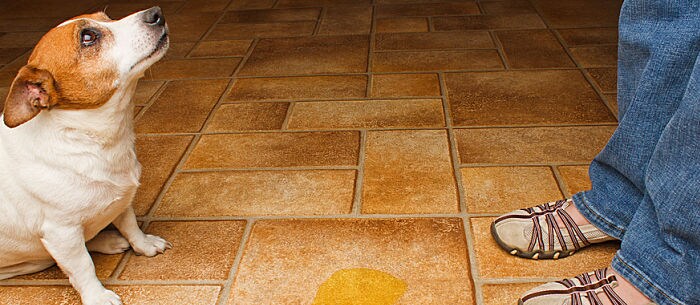A dog bladder infection is fairly common. What’s tough is that dogs can’t tell you what they’re feeling, so it can be a challenge to figure out what is happening with your furry friend.
“Your dog will not complain or tell you if it burns to urinate,” shares Dr. Lori Pasternak of Helping Hands Affordable Veterinary Surgery and Dental Care in Richmond, Virginia, who’s been a practicing vet for the past 17 years. “You must rely on the dog’s behavior. However, by the time you see these behavioral changes, the bladder infection may be quite severe.”
Some of the behaviors to look for in your dog include:
- Increased thirst and drinking more water than normal
- Fatigue or sluggishness
- An urgency to urinate or having accidents despite being previously house-trained
- Licking at urinary opening
- Whining, crying out or straining when urinating
Besides the above behaviors, your dog might have some other symptoms, particularly if the infection is advanced. Dr. Wendy McCulloch of Home Vets NYC, who’s been practicing veterinary medicine for 11 years, agrees that symptoms of a dog bladder infection (also referred to as cystitis) and accompanying behaviors initially may be hard to identify.
Here are some symptoms to look for:
- Loss of appetite
- Fever
- Visible blood in the urine
- Urine that smells bad
- Passing small amounts of urine frequently
Females are more prone to a dog bladder infection because they have shorter urethras.
If you notice any of the above symptoms or behaviors, call your vet, who will most likely test for a bladder infection.
Treatment
Once an infection is identified, a course of antibiotics is the typical treatment. Your vet might also prescribe a 24-hour course of anti-inflammatory or pain medication to make your dog more comfortable. If your vet does not suggest pain medication but you feel that your pet is really uncomfortable, ask about it.
You may also want to ask your vet about natural remedies, like cranberry supplements. Make sure to get information about not only the products but also about the dosage that’s right for your pet. In addition, let your vet know if your dog has a hard time with certain forms of medication, such as pills and/or pill pockets. A veterinary compounding pharmacy can turn your dog’s medication into a treat or something more appealing to help in administering the medicine.
Tips
Here are some tips that Drs. Pasternak and McCulloch recommend to help while your dog recovers:
- Make sure your dog has access to plenty of fresh, clean water and is on a diet of wet food (at least until the infection has cleared), as this will further increase his water intake.
- Make sure you administer your dog’s medication on schedule and ensure that he is swallowing the pill or getting the full dose of liquid prescribed. Don’t stop medication if your dog seems better. Follow the full course based on your vet’s instructions.
- Do not reprimand or scold your dog for an accident that happens during this time. When a dog has a bladder infection, accidents are to be expected, so take any necessary steps to protect your floors or sofas with training pads or a “piddle pad.”
- If your dog is not responding to the medication or recommended treatment within 48 hours, let your vet know right away.
- Take your dog out and allow your pet to urinate regularly. Holding urine for long stretches on a regular basis can contribute to and make urinary bladder infections worse.
- Your vet might prescribe a special diet to alter the pH of your pet’s urine to make bacterial growth less likely in the future. For this prescription diet to work, you’ll need to feed only what is prescribed, which may mean no treats or table scraps.
- Be sure to let your dog sitter, walker or doggy day care provider know about your pet’s condition. Make sure everyone has access to the tips above and fully understands how to administer your dog’s medication if necessary.
After the prescribed course of treatment, follow up with your vet and have your dog’s urine rechecked to be sure the infection has cleared.
If you’re worried about kidney failure in dogs, check out this article.
Laura Richards is a Boston-based freelance writer and the mother of four boys, including a set of identical twins. She is also mom to three rescue pets: Scarlett, a 7-year-old beagle, and Edith and Ollie, 15-year-old identical twin black cats. She has written for numerous parenting publications and is the president of On Point Communications.
*This article is for general informational purposes only. It is not intended nor implied to be providing medical advice and is not a substitute for such advice. The reader should always consult a health care provider concerning any medical condition or treatment plan. Neither Care.com nor the author assumes any responsibility or liability with respect to use of any information contained herein.







